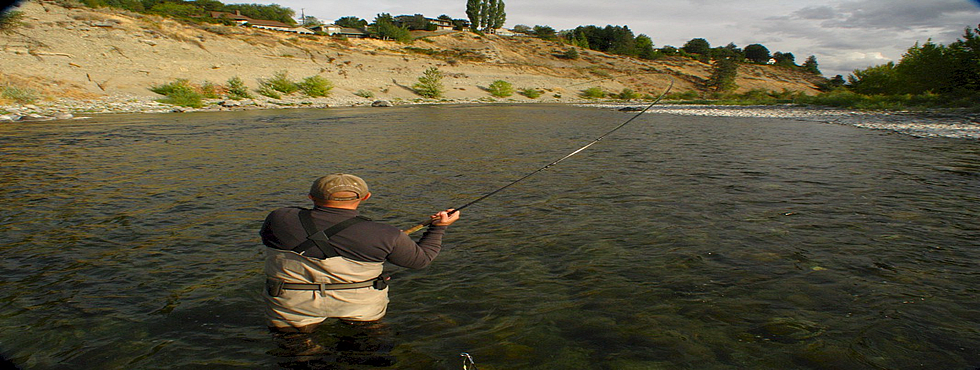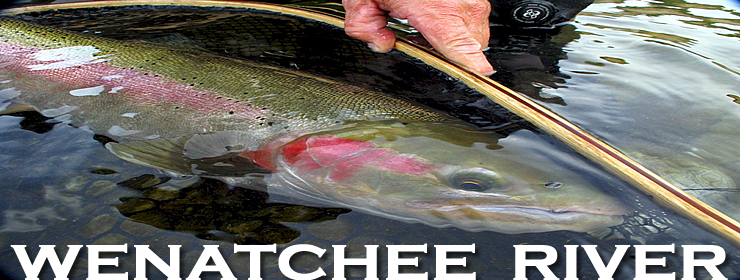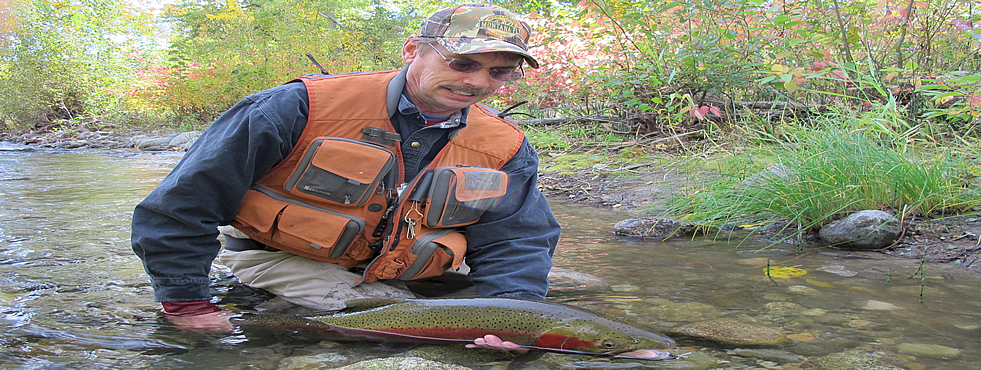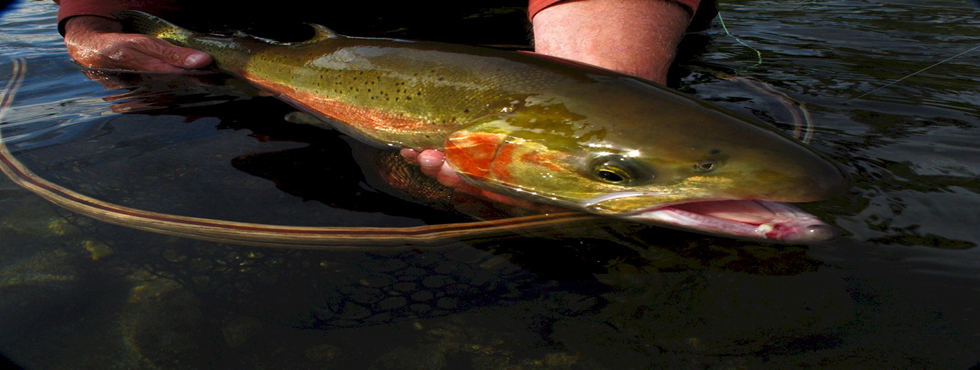|
I went to the Wenatchee
River in 1997 for a day of fishing, however after a long period of
low steelhead run return years, the river was left sterile of fish and my
hopes of catching a magnificent Wenatchee River Steelhead, soon went out
the window for me. That year, Wenatchee River steelhead was listed
as an Endangered Species and the river was closed to steelhead
fishing for over a decade. To this day, Wenatchee River wild
steelhead is still listed "threatened" within the Upper Columbia.
The Wenatchee falls within the Upper Columbia distinct population
segment, which are comprised of all naturally produced steelhead as
well as six hatchery populations from the Yakima River upstream to
the US border. The current state of Steelhead in the Wenatchee River
has been up and down over the past several years. In 1997 they were
listed as endangered, however in 2006, the Wenatchee River Steelhead were upgraded or down graded, however you want to think of it as, to threatened. A
court reversal downgraded the status of these fish to endangered in 2007 and then
again changed their opionion and their current status back to threatened
in 2009. However, time changes everything and a decade later, the Columbia Basin steelhead has greatly rebounded from their plight during the 1990s. Most biologists cite improved ocean conditions as the main factor influencing increased returns
of these ocean going rainbow trout. However, the freshwater survival rate has improved as well. |
|
|
|
This is most likely due to increased spill and flow rates at the main stem dams on the Columbia River, when steelhead smolts
are swimming downstream on their journey to the Pacific Ocean.
Data…there is no denying it, fish
biologists love numbers. In 2001, 28,602 steelhead ascended the Rock
Island Dam, which is just below the confluence of the Wenatchee and Columbia River. This was the second mass return of steelhead since 1977. There were lots of fish in the
Upper Columbia! The Washington Department of Fish & Wildlife began an intensive study on Wenatchee River Steelhead. Fish traps were set in place throughout their migaratory route up
river throughtout the Wenatchee River system. They were stopped in the traps, sampled, and tagged to determine their migratory patterns. However,
the Wenatchee remained closed to all fishing because of the ESA listing. But the a surprising trend of returning fish was increasing over time. The 10-year average at Rock Island Dam and Rocky Reach Dam on the Columbia River was now 9,944 and 7,160, respectively. The difference between the two-Chelan PUD operated hydro
electric projects was 2,784 and presumably, these fish were heading into the Wenatchee River system. Another dam on the Wenatchee located upstream of the town of Leavenworth is the Tumwater facility. All anadromous fish, including steelhead, are counted as they pass thru the barrier ladder and some are sampled at
the Tumwater Dam. The 10-year average is 1550. In 2009, a modern-day record 37,796 steelhead passed thru the fish ladder at the Rock Island Dam. In 2007, because of the relatively large returns
of steelhead, the Wenatchee River was reopened by NOAA fisheries and Washington Department of Fish & Game. An "emergency”opening was announced to anglers and their help was needed to reduce the number of hatchery steelhead returning to the Wenatchee.
For the first time in over a decade the river was open to fishing and anglers, both fly and gear came out in droves to "kill" and remove hatchery steelhead from the river. These were the same fish
genetics and generations that aided in rebuilding the overall run of fish to begin with. Fishermen of all kinds drank the kool-aid and stringers of steelhead left the river. |
|
|
|
How can this be? Nobody ever heard of a kill season on bald eagles, another threatened and endangers species throughout the United States? Weren’t Upper Columbia River Steelhead on the same endangered
species list as our nation's symbol? The supposed difference be the two? Too many hatchery fish in the system = an inferior gene pool. Fisheries management solution was to use the public sportsmen as a tool
to remove the same byproduct that had been instituting for decades. Because of the inadequate number of steelhead displaced throughout the river system hatchery supplementation of steelhead was needed
to repair the destruction of the true wild species. This is hypocrisy at it's finest! In order to conserve the genetic material found in naturally produced steelhead, fishery managers were required to remove hatchery fish off the spawning grounds. A steelhead fishery was opened on the Wenatchee in 2009 and 2010, which included 4-fish limits of hatchery steelhead. The latter two years required mandatory retention of hatchery fish, a regulation that didn’t sit well with many fly fishermen.
After years of practicing catch and release fishing, many could not resort to killing the very fish they prized so much and refused to take part in a kill fishery. Fishery managers conclude that just over 1,000 wild steelhead are needed to seed the available spawning and rearing habitat available to them in the Wenatchee
River system. Too many hatchery fish in the system supposably can cause several problems:
Hatchery fish using spawning habitat that should be reserved for wild fish-spawning Hatchery fish spawning on top of wild fish redds which can and will dilute wild fish genetics- occupying rearing space used by wild fish and potential predation issues on ESA listed species (Spring Chinook, Steelhead, and Bull Trout).
It is a fallible situation at best. |
|
|
|
Hatchery
fish are released to help recover stocks but too many
can create a problem for fishery managers. With the help
of the angling population, their opionion was to reduce the number of
hatchery fish through a special “emergency opening”
fishery. There is nothing to sugar coat here...make no
mistake, this fishery is nothing short of a complete
kill fishery to reduce the amount of hatchery fish in
the system. The Methow River less then a 100 miles to
the north is open for the same reason. Remove the
hatchery fish (identified by a missing or clipped adipose
fin)…period. But the alternative isn’t pretty either,
which is allowing the hatchery fish to potentially
impact wild fish recovery. At least we can fish for
steelhead in the Wenatchee River once again and for the
time being, perhaps wild steelhead stand a chance at
recovery.? In the fall of 2007, I found myself swinging a Green Butt Skunk on a floating line in October on the same water that many of the fly fishing gurus had done in previous years past. With warm, pleasant days, cool, crisp nights and the feel of fall in the air it felt right to be standing on the slick buttery rock bottom of the Wenatchee
River. The only difference between now and yesteryear is that instead of just harvesting fruit in the Wenatchee Valley, hatchery steelhead have also become part of the yield. Life as we know it may not always be perfect and the situation that we find ourselves in can at times confront new challenges. When it comes to steelhead, passions ensue and ignite in many anglers. The plight of wild steelhead is constantly at risk
from year to year. For many doing their work to insure the survival of wild sustainable fish populations, we thank you. At this time, in the year 2020 the Wenatchee River system remains closed to fishing. Each year, fly fishermen wait in anticipation for an announcement of a "special" steelhead opening on the Wenatchee
River system. In 2013, the river was opened to a "catch & kill" removal of all hatchery supplemental steelhead. To date, it has not been reopened for any and all sport fishing. The
Wenatchee River remains closed and the hopes of every seeing it reopened to sport fishing seem insurmountable. |
 |
|
|






